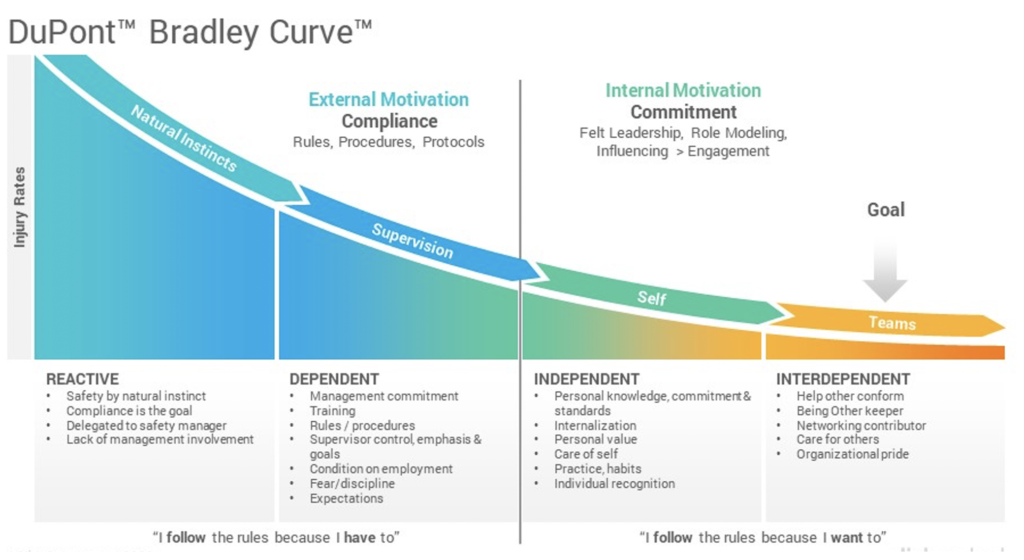 Wellbeing is a team sport
Wellbeing is a team sport
In the 1990s, DuPont CEO Ed Woolard chartered the so-called DuPont Discovery Team to develop a system that would allow sustainable and lasting improvement in organisational safety. One of the best known outcomes of that team is the Bradley Curve developed in 1994.
The Bradley Curve helps organisations to understand the point they’re at in their journey towards an effective safety culture.
The curve seeks to highlight 4 stages of development or maturity in an organisations safety culture moving from reactive (with the highest injury rates) through to Interdependent (with the lowest injury rates). It looks at the reactive stage of safety culture as being driven mostly be people’s natural instincts. Following these instincts without being mindful of risks leads to poorer safety outcomes. When the culture shifts through the next stages supervision plays a role in improved safety, self awareness is better but the ultimate safety culture is based on a team’s focus. When people develop the mindset and habits to truly care for others and help each other conform to effective practices by having each other’s back, more people go home safe each night. People are interdependent on looking after each other.
So what does any of this have to do with wellbeing?
Wellbeing is been increasingly recognised as a critical focal point for organisations as they realise people’s physical, mental and emotional states don’t just automatically take care of themselves. With increased levels of uncertainty in the current environment greater than at any point in decades, this has implications for people’s happiness and how they show up at work. We know that people perform at their best when they have a high level of wellbeing. A meta-analysis of independent studies accumulated by Gallup was conducted in 2019, covering the wellbeing and productivity of nearly 2 million employees and the performance of over 80,000 business units, originating from 230 independent organisations across 49 industries in 73 countries. The results suggest a strong positive correlation between employee wellbeing, productivity, and firm performance.
How do you help people sustainably improve their wellbeing?
According to Psychology Today, Well-being is the experience of health, happiness, and prosperity. It includes having good mental health, high life satisfaction, a sense of meaning or purpose, and ability to manage stress.
Many organisations are tackling wellbeing on the basis of helping educate individuals to practices that help their own self awareness and self management. However if we take the lessons from a culture of physical safety from the Bradley curve, we can also apply it to psychological, mental and emotional safety (wellbeing). When we feel connected to others (as opposed to isolated), when we have others we trust around us we can lean on (as opposed going it on our own), we can more effectively boost the wellbeing of ourselves and others. Our happiness and sense of purpose at work are inextricably linked to those around us. Ever experienced a manager who lacks empathy, conflict amongst team members or been a part of a team that’s not clear on its priorities? All of these will detract from our wellbeing. The fourth stage of the Bradley Curve, Interdependence is about a culture of care. Whilst it’s good to train ourselves in managing our own wellbeing, we’ll get a much better result if we also focus on the wellbeing of the team as a collective. For us humans, like it or not, wellbeing is a team sport.





